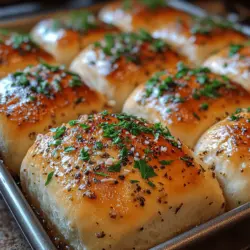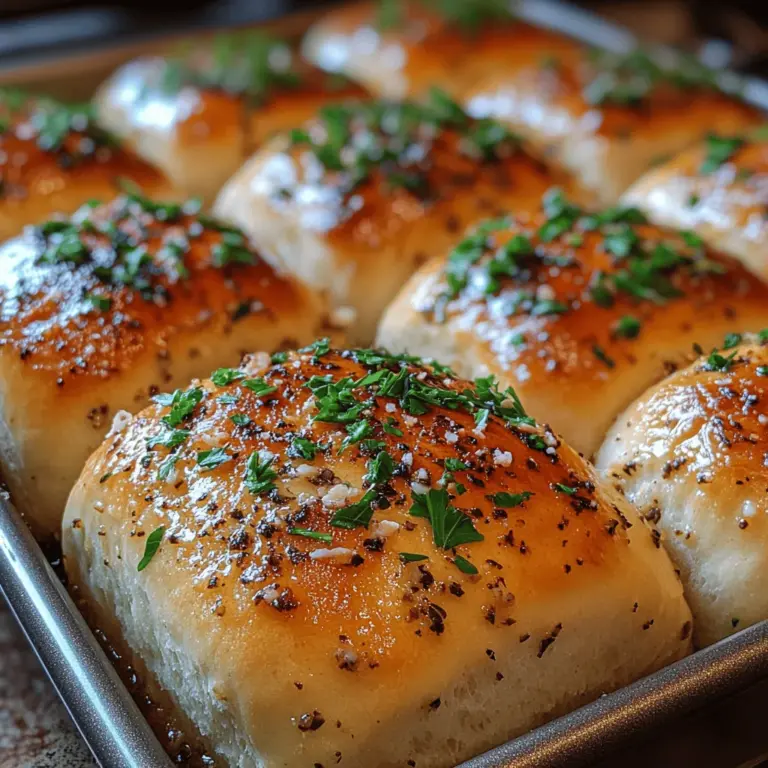Introduction
There’s something undeniably comforting about the aroma of freshly baked bread wafting through the kitchen. Homemade bread rolls not only fill your home with warmth and nostalgia but also elevate any meal to a new level of delight. Among the myriad of bread roll recipes out there, Heavenly Buttery Garlic Herb Rolls stand out as a true crowd-pleaser. Their fluffy texture and rich flavor profile create a harmonious blend of garlic and aromatic herbs that perfectly complements a variety of dishes, from a simple weeknight dinner to a lavish holiday feast.
The combination of garlic and herbs in these rolls doesn’t just tantalize the taste buds; it also brings a host of health benefits. Garlic is known for its immune-boosting properties, while fresh herbs add vibrant flavor without extra calories. When combined in a soft, buttery roll, these ingredients create an irresistible treat that can be enjoyed on its own or as a delightful accompaniment to soups, salads, or main courses.
Whether you’re planning a family gathering, hosting a dinner party, or simply looking for a way to enhance your weeknight meals, these Heavenly Buttery Garlic Herb Rolls are the perfect choice. With their golden-brown crust and soft, pillowy interior, they will surely impress your guests and leave everyone asking for the recipe.
Understanding the Ingredients
To create these heavenly rolls, it’s essential to understand the role of each ingredient in the recipe. Here’s a breakdown of the key components that come together to form the perfect garlic herb rolls:
All-Purpose Flour
All-purpose flour is the backbone of any bread recipe. Its moderate protein content provides the necessary structure and texture to create a light and fluffy roll. When combined with the right amount of liquid, the flour develops gluten, which gives the dough elasticity and allows it to rise properly. While you can experiment with different flours, all-purpose flour remains the most reliable choice for achieving consistency and a delightful crumb.
Active Dry Yeast
Yeast is the magic ingredient that transforms simple dough into airy and light rolls. Active dry yeast must be activated before use, usually by dissolving it in warm liquid. This process kickstarts the fermentation, during which the yeast feeds on sugars and produces carbon dioxide, causing the dough to rise. The fermentation process not only contributes to the volume of the rolls but also enhances the flavor.
Warm Milk
Warm milk plays a dual role in this recipe. First, it serves as a hydrating agent, helping to bring the dough together. The warmth of the milk is crucial for activating the yeast, as it encourages the yeast to start bubbling and fermenting. Additionally, using milk adds richness to the dough, creating a softer texture in the finished rolls.
Granulated Sugar
Sugar is more than just a sweetener in this recipe; it also feeds the yeast, promoting its growth and fermentation. A small amount of granulated sugar enhances the overall flavor of the rolls, giving them a slight sweetness that balances the savory garlic and herbs. It also aids in browning the crust, resulting in a beautifully golden exterior.
Unsalted Butter
Butter is a key ingredient that adds richness and flavor to the rolls. Unsalted butter is preferred in baking as it allows for better control over the salt content in the recipe. When melted and incorporated into the dough, butter contributes to a tender texture and enhances the overall taste of the rolls.
Egg
An egg acts as a binding agent in the dough, helping to hold all the ingredients together. It also adds moisture and richness, resulting in a tender roll. Moreover, the egg contributes to a beautiful golden color when the rolls are baked, making them visually appealing as well.
Salt
Salt is an essential ingredient in bread-making that enhances flavor and controls yeast activity. It strengthens the gluten structure, which is vital for developing a good texture in the rolls. While it’s crucial to add the right amount of salt, too much can inhibit yeast growth, so measuring carefully is essential.
Garlic and Herbs
Garlic is the star flavor of these rolls, infusing them with a robust taste that pairs beautifully with the soft, buttery texture. Fresh herbs, such as parsley, add a bright, aromatic note that elevates the rolls even further. Together, garlic and herbs not only create a delightful flavor profile but also bring numerous health benefits, including anti-inflammatory and antioxidant properties.
Fresh Parsley and Optional Parmesan Cheese
Fresh parsley serves as a garnish and flavor enhancer, adding a pop of color and freshness to the rolls. It can be mixed into the dough or sprinkled on top before serving. For those who want to elevate the flavor even more, adding grated Parmesan cheese can provide a savory, umami kick that complements the garlic and herbs beautifully.
Step-by-Step Instructions: Crafting the Perfect Rolls
Now that we’ve covered the essential ingredients, it’s time to dive into the step-by-step process of crafting these Heavenly Buttery Garlic Herb Rolls. Follow these instructions carefully to ensure that your rolls turn out soft, fluffy, and bursting with flavor.
Activating the Yeast
1. Prepare the Yeast Mixture: Start by measuring out the warm milk, ensuring that it’s between 100°F to 110°F (37°C to 43°C). This temperature range is crucial, as water that’s too hot can kill the yeast, while water that’s too cold will not activate it properly.
2. Combine Ingredients: In a small bowl, combine the warm milk, granulated sugar, and active dry yeast. Stir gently to dissolve the yeast and sugar, then let it sit for about 5 to 10 minutes. During this time, the mixture should become foamy, indicating that the yeast is active and ready to work its magic.
Making the Dough
3. Mix the Dry Ingredients: In a large mixing bowl, whisk together the all-purpose flour and salt. This step ensures that the salt is evenly distributed, which is important for controlling the yeast’s activity.
4. Combine Wet and Dry: Once the yeast mixture is frothy, add it to the bowl with the dry ingredients. Next, incorporate the melted unsalted butter and the beaten egg. Use a wooden spoon or spatula to mix everything together until a shaggy dough forms.
5. Knead the Dough: Transfer the dough to a lightly floured surface. Knead the dough for about 8 to 10 minutes, or until it becomes smooth and elastic. If the dough is too sticky, sprinkle a little more flour as needed, but be cautious not to add too much, as this can make the rolls dense.
6. First Rise: Form the kneaded dough into a ball and place it in a greased bowl, turning it to coat all sides with oil. Cover the bowl with a clean kitchen towel or plastic wrap, and let it rise in a warm, draft-free area for about 1 to 1.5 hours, or until it has doubled in size.
With the dough rising, you can prepare yourself for the next steps, where we’ll guide you through shaping the rolls and the final rise before baking. Stay tuned for the continuation of this flavorful journey into the world of Heavenly Buttery Garlic Herb Rolls!
{{image_2}}
Kneading Techniques
Kneading is a crucial step in the bread-making process, particularly for our Heavenly Buttery Garlic Herb Rolls. This technique is essential for gluten development, which gives the dough its structure and elasticity. When kneading, you’re working the flour proteins—glutenin and gliadin—into gluten, which traps air bubbles and helps the dough rise.
To knead effectively, turn the dough out onto a lightly floured surface and use the heel of your hand to push the dough away from you. Fold it back over itself and turn it 90 degrees before repeating the process. Aim for about 8-10 minutes of kneading until the dough is smooth and elastic. A well-kneaded dough will bounce back when poked and feel slightly tacky but not sticky.
First Rise
Once kneaded, it’s time for the first rise, also known as fermentation. This step is crucial for developing flavor and texture in your rolls. For optimal rising conditions, place your dough in a warm, draft-free area. A common trick is to turn your oven on to the lowest setting for a minute, then turn it off, creating a cozy environment for the dough to rise.
Cover the bowl with a clean kitchen towel or plastic wrap to prevent the surface from drying out. The first rise typically takes about 1 hour, but visual cues can help determine readiness. The dough should double in size and feel light and airy. To check if it’s ready, gently press two fingers into the dough; if the indentation remains, the dough is ready for the next step.
Preparing Garlic Herb Butter
While the dough is rising, take the opportunity to prepare your garlic herb butter. This flavored butter will not only enhance the rolls but also provide a rich, savory finish.
Start with half a cup of unsalted butter at room temperature. Add 3-4 cloves of freshly minced garlic, 1 tablespoon of finely chopped fresh parsley, and 1 teaspoon of dried oregano. For a hint of brightness, you can even add a squeeze of lemon juice. Mix these ingredients thoroughly until combined. This garlic herb butter will be brushed on the rolls before baking, ensuring each bite is infused with aromatic flavor.
Shaping the Rolls
After the first rise, it’s time to shape the rolls. Gently punch down the dough to release any trapped air and transfer it to a lightly floured surface. Divide the dough into equal pieces, about 12-15, depending on your desired roll size. For uniformity, you might consider weighing each piece to ensure they are consistent.
To shape each piece, flatten it slightly, fold the edges toward the center, and then roll it into a ball. Place the shaped rolls seam-side down in a greased baking dish, ensuring they are close but not touching. This technique not only creates uniform rolls but also allows them to rise beautifully together during the second rise.
Second Rise
Now, patience is key as we prepare for the second rise. Cover the rolls with a clean towel again and let them sit in a warm area for about 30-45 minutes. During this time, the rolls will puff up and become light and airy, ready for baking.
The importance of this step cannot be overstated; proper fermentation impacts the texture and flavor of the finished rolls. If you rush this process, you risk ending up with dense, heavy rolls. Look for the rolls to double in size, which is an indicator that they are ready to bake.
Preheating the Oven
As the rolls undergo their second rise, it’s a good time to preheat your oven to 375°F (190°C). Preheating ensures that the rolls will bake evenly and at the correct temperature from the start, allowing them to rise beautifully and develop a golden-brown crust.
Baking to Perfection
With the oven preheated and the rolls ready, it’s time to bake. Place the rolls in the center of the oven and bake for approximately 20-25 minutes. Keep an eye on them; they should turn a lovely golden brown, and the kitchen will be filled with the irresistible aroma of garlic and herbs.
To check for doneness, tap the bottom of a roll; if it sounds hollow, that’s a good sign. An internal temperature of about 190°F (88°C) also indicates that the rolls are fully baked.
Final Touch
As soon as you remove the rolls from the oven, brush them generously with the prepared garlic herb butter. This final touch is not just for flavor; it adds a beautiful, glossy finish to the rolls, making them even more appealing. Allow the rolls to cool slightly before serving, as this will enhance their texture and flavor.
Presentation and Serving Suggestions
When it comes to serving your Heavenly Buttery Garlic Herb Rolls, presentation can elevate the entire dining experience. Arrange the rolls in a rustic wooden basket lined with a cloth napkin for a cozy, inviting look. Alternatively, you can place them on a beautiful serving platter, garnished with extra sprigs of fresh herbs or a small bowl of extra garlic herb butter for dipping.
These rolls are incredibly versatile and pair well with a variety of dishes. Consider serving them alongside a hearty soup, such as a creamy tomato basil or a classic minestrone. They also make a wonderful accompaniment to salads, particularly a Caesar or mixed greens salad with a light vinaigrette. For a more substantial meal, serve the rolls with grilled meats or roasted vegetables, allowing the rich flavors to complement one another.
It’s essential to serve these rolls warm to fully appreciate their buttery goodness. If they cool down, you can reheat them briefly in the oven to restore their fluffy texture before serving.
Nutritional Information
While Heavenly Buttery Garlic Herb Rolls are undeniably indulgent, they can also provide some nutritional benefits. Made primarily from flour, butter, garlic, and herbs, these rolls offer carbohydrates for energy, healthy fats from the butter, and garlic, which has been linked to various health benefits, including improved heart health and immune function.
Each roll contains approximately 150-200 calories, depending on size and specific ingredients used. They also provide a small amount of protein and dietary fiber, especially if you opt for whole wheat flour.
For those with dietary restrictions, consider experimenting with gluten-free flour blends to create a similar texture. You can also reduce the butter or substitute it with a plant-based alternative for a lighter version, making these rolls more accessible to a broader audience.
Conclusion
Making homemade Heavenly Buttery Garlic Herb Rolls is not just a baking project; it’s an opportunity to create something truly special for your family and friends. The process, from kneading the dough to brushing on the garlic herb butter, is satisfying and can be a delightful experience in the kitchen.
These rolls are sure to elevate any dining experience, whether it’s a casual family dinner or a festive gathering. Their irresistible aroma, fluffy texture, and rich flavor will leave guests asking for seconds, or even thirds. So, roll up your sleeves, gather your ingredients, and enjoy the process of baking these heavenly rolls. You won’t just end up with delicious bread; you’ll also create lasting memories around the table.



